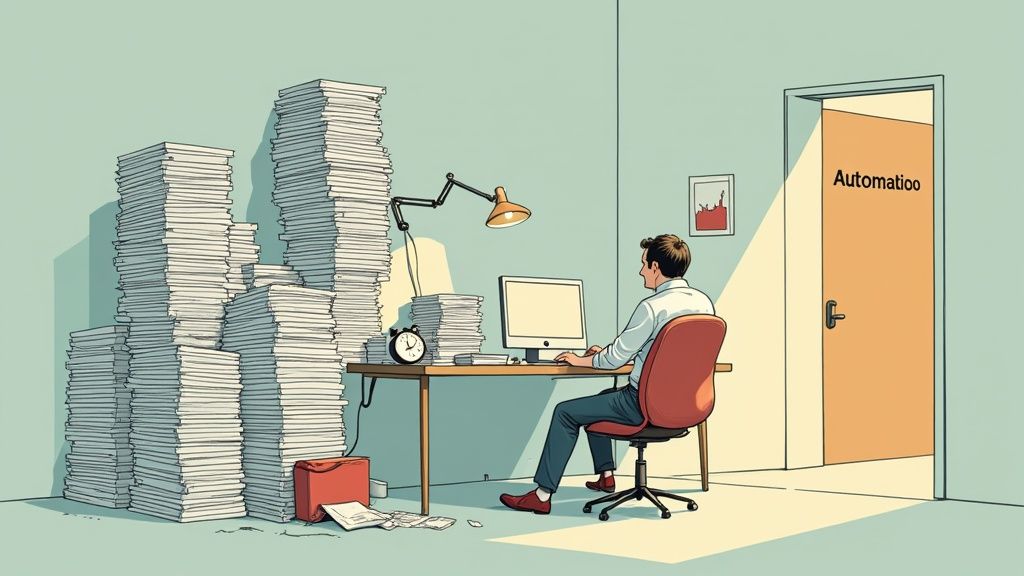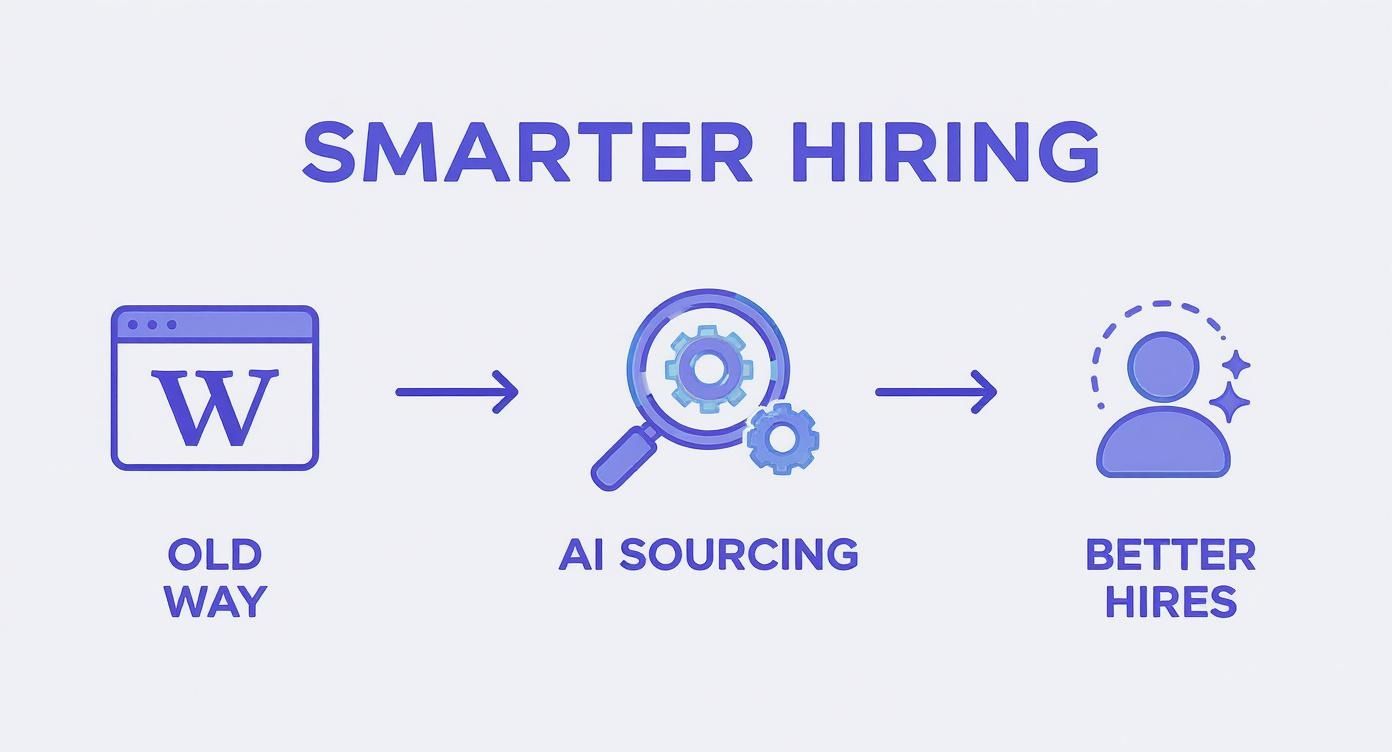
Let's be real. Traditional recruiting is a productivity black hole. It’s a swamp of endless resumes, ghosting candidates, and spending weeks on a hire who ultimately doesn't work out. I’ve lived it.
So, when we talk about streamlining the recruitment process, we’re not just talking about being faster. We're talking about using tech and smarter workflows to hire better people, slash costs, and fix the entire experience for everyone involved. It’s the difference between a hiring machine and a hiring mess.
Before we dive into how to fix it, let's get painfully honest about why it's so broken. This isn't just about saving time; it's about reclaiming your team's sanity.
You know the feeling. You're drowning in spreadsheets, your calendar looks like a Jackson Pollock painting of interview invites, and your best engineer is now a part-time recruiter. That's the manual recruiting grind, and it’s time to escape.

A slow, manual hiring process is more than an annoyance. It’s actively costing you money and top talent. We’ve all been there—trying to fill a critical role while the rest of the team picks up the slack, slowly burning out. The longer a position stays open, the more it hurts.
The real damage is happening in places you might not even be tracking:
The $500 Hello: We used to call it this—the estimated cost in wasted team time for every single interview that ended in a no-show. It’s a painfully expensive way to learn your process is broken.
The moment you realize your hiring “system” is just a chaotic series of spreadsheets and manual follow-ups is your wake-up call. Hope you enjoy spending your afternoons fact-checking resumes and running technical interviews—because that’s now your full-time job.
This isn’t about minor tweaks. It’s about a fundamental rethinking of how you find and attract people.
The goal is to be smarter, more deliberate, and less likely to make you want to throw your laptop out the window after screening the tenth unqualified applicant. Consider this group therapy for everyone stuck in the manual recruiting grind. It's time to get out.
If a robot can do it, a robot should do it. Let’s be ruthless about this. Your first move in streamlining recruitment is to automate every single repetitive task that drains your team's will to live.
This isn’t about replacing recruiters with soulless machines. It’s about upgrading them from resume-sorting drones into strategic talent partners. We're getting them out of the spreadsheet mines so they can focus on what actually matters—talking to brilliant humans.

So, where do you begin without mortgaging the office ping-pong table for some shiny new software? You target the biggest time sinks first. These are the low-hanging fruits of inefficiency that are secretly killing your team’s productivity.
We’re talking about tasks that require zero creativity but consume dozens of hours a week. For most teams, the worst offenders are:
The numbers don't lie. The global average time to hire is a painful 44 days. But here's the kicker: companies that embrace AI-driven tools have cut this down by as much as 50%.
Think about that. You could be making hires in 22 days or less, simply by letting technology handle the grunt work.
The goal isn’t just to be faster. It’s to reclaim your team’s brainpower. Every hour saved on scheduling is an hour they can spend building relationships with top candidates.
Now for the fun part—picking your weapons. A good Applicant Tracking System (ATS) is non-negotiable. It’s your command center. But not all tools are created equal. Some are just glorified spreadsheets with a prettier interface.
You need a platform with robust recruitment automation software that genuinely takes work off your plate. For real-world insights into implementing this beyond just HR, check out these business process automation examples to get your gears turning.
Here’s my pragmatic, no-fluff checklist for what actually matters in an automation tool:
Choose wisely. The right automation stack doesn't just streamline your process; it becomes a competitive advantage that lets you engage and win top talent while everyone else is still stuck in their inbox.
Still posting on the same old job boards? Then don’t be surprised when you get the same old candidates. Making your hiring process more efficient isn’t just about moving faster—it’s about improving the quality of who you hire. A truly streamlined process uncovers incredible people you didn't even know existed.
This is the critical shift from reactive hiring (passively waiting for whoever applies) to proactive talent acquisition. It’s about casting a wider, smarter net. Turns out there’s more than one way to hire elite developers without mortgaging your office ping-pong table.
Let’s be honest: the most valuable candidates often aren't scrolling through job ads. They’re busy doing great work for someone else. These are the passive candidates, and they represent the top tier of talent you’re probably missing out on right now.
So, how do you find them without spending all day stalking profiles on LinkedIn? This is where modern AI sourcing tools come in. These platforms don't just scrape job sites; they scan the entire web for signals of genuine expertise.
They’re looking for tangible proof of skill, like:
This approach completely changes the game. It moves the focus from flimsy resume keywords to proven, real-world skills. To really get ahead, applying planning artificial intelligence principles can fundamentally change how your team identifies and engages this top-tier talent.
Once you've cast that wider net, you need a way to sort through the inbound interest without creating a new manual bottleneck. This is where AI-powered screening becomes non-negotiable for anyone serious about streamlining their recruitment process.
These tools can analyze profiles, portfolios, and resumes in seconds, handing you a qualified shortlist. This lets your team jump straight to what they do best: engaging the most promising people. The efficiency gains are massive. In fact, research shows that AI screening tools can slash the time spent on resume review by up to 75%.
For companies drowning in applications, this has led to a reported 10x increase in candidate processing capacity. That's a huge leap in productivity.
The goal isn't just to find more people. It's to find the right people faster, so your team can spend its time building relationships, not sifting through unqualified leads.
Building a proactive sourcing engine is the foundation for a rock-solid talent pipeline. By continuously identifying and nurturing relationships with top professionals, you’ll have a pool of warm candidates ready to go the moment a new role opens up. Our guide on how to build a talent pipeline dives much deeper into this essential long-term strategy.
That five-stage, six-hour interview gauntlet you’re running? It isn’t finding you the best candidate. It’s just finding the most patient one.
Let’s be blunt: a bloated interview process is a sign of internal indecision, not thoroughness. It wastes everyone's time and, worse, pushes top talent—the ones with plenty of options—straight into the arms of your faster-moving competitors.
It's time to tear down that old structure and rebuild it for a world that moves faster than your approval chain. Every minute should count, for both you and the candidate, giving you a clear signal on skills and fit without all the theatrical fluff.
The visual below shows the simple shift from the slow, old way to a smarter, more direct approach.

As you can see, swapping outdated job boards for AI-driven sourcing is just the start. The real magic happens when you pair that with a process that actually leads to better hires, minus the friction.
I’ve conducted more interviews than I care to admit, and I can tell you that most of them were a complete waste of time. Endless questions about someone's "biggest weakness" don't predict job performance. They just test a candidate’s ability to deliver a well-rehearsed, generic answer.
My framework is much simpler: get the most valuable data you need in 90 minutes, not nine hours. It’s all about consolidating rounds and asking questions that actually reveal something meaningful.
This requires a few key shifts:
For a deeper dive, our guide on effective online interview techniques can help you perfect this modern approach.
Stop asking candidates where they see themselves in five years. You're not their career counselor. Instead, every question should be laser-focused on past behavior and future problem-solving.
Your goal isn't to see if they can answer your questions. It's to see if they can solve your problems. Every minute of an interview should be spent figuring that out.
Try these instead:
By redesigning your interview process, you’re not just saving time. You’re sending a powerful message to candidates that you are decisive, respect their time, and are focused on what truly matters. And that’s a company people actually want to join.
In a competitive market, your hiring process is a product. And right now, your product probably needs some work. Let’s face it, every resume that disappears into a black hole and every unreturned email shoves great talent directly toward your competitors.
Streamlining your internal workflow is only half the battle. The other half is creating an external experience that makes people want to work with you. You've got to treat your candidates like valued customers, because the best ones absolutely are.
The single biggest complaint from candidates? Getting ghosted. A shocking 75% of applicants never hear back after submitting their resume. That’s not just rude; it’s a terrible business practice that damages your reputation.
This isn't hard to fix. Most modern Applicant Tracking Systems (ATS) can send automated emails at key stages of the process. A simple "We've received your application and will be in touch if there's a match" is the bare minimum. It takes zero effort and prevents you from looking like you don’t have your act together.
Here are a few small, high-impact changes that make a huge difference:
Here's a radical idea: what if you provided actual, useful feedback to the candidates you reject? I know, it sounds like a lot of work, but the payoff is immense. Most companies avoid it for fear of legal blowback, but you can give meaningful feedback without opening yourself up to risk.
One of our biggest 'Oh, wow' moments came when we started sending a simple, two-sentence feedback email to our final-round rejections. The response was incredible. Candidates who didn't get the job started referring their friends to us. They became brand evangelists.
Instead of a generic "we've decided to move forward with other candidates," try something specific but safe.
For example, a rejection email could include a line like: "While your experience in project management was impressive, the candidate we moved forward with had deeper expertise in the specific B2B SaaS tools our team uses daily."
It’s honest, helpful, and respectful. It closes the loop and leaves people with a positive impression of your company. That positive impression is how you build a long-term talent pipeline, turning today’s rejected candidates into tomorrow’s perfect hires. It's a simple change that shifts your hiring process from a transaction to a relationship.
Alright, let's get into the weeds. Once you start talking about automation and making your hiring process more efficient, the same questions always pop up. It's usually a mix of healthy skepticism and a genuine fear of turning your hiring into a cold, robotic mess.
These are fair concerns. So, let’s tackle the big ones head-on, founder to founder.
That’s the million-dollar question, isn't it? The big fear is that we’ll all be hired by Skynet, and our first day will involve a loyalty pledge to our new machine overlords.
But here’s the contrarian take: using AI for the right tasks actually makes your process more human. Think about it. When you automate the soul-crushing administrative work—sifting through 500 identical resumes, scheduling 12 interviews across four time zones—you free up your team for actual human interaction.
The key is to automate the transactional and humanize the relational. A robot can’t convey your company culture over a video call, but it can sure as hell figure out who meets the basic job requirements faster than you can.
By offloading the grunt work, your team gets to spend their time on what matters: building rapport, answering tough questions, and selling your vision to top candidates. Suddenly, they're not just gatekeepers; they're ambassadors.
Forget boiling the ocean. If you’re still managing candidates in a spreadsheet, the single biggest bang for your buck is implementing an Applicant Tracking System (ATS) with strong automation. Stop what you’re doing right now and fix this. Seriously.
An ATS is your command center. It automates communication, screens initial applications based on your rules, and gives you a single source of truth for every candidate. This one move eliminates the black hole where applications go to die and immediately makes your entire operation look more professional.
It's the 20% effort that solves 80% of your initial streamlining headaches.
If you can't measure it, you can't manage it. Ditch the vanity metrics and focus on the data that actually moves the needle. A streamlined process should deliver tangible results, not just feel faster.
Here are the only three metrics you really need to care about:
If your Time to Fill drops while your Quality of Hire and Offer Acceptance rates go up, you’re not just streamlining—you’re winning. We’re not saying we’re perfect. Just more accurate more often. (Toot, toot!)